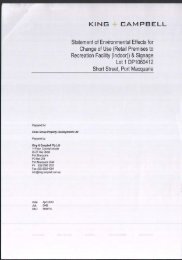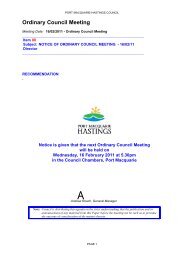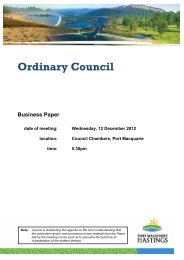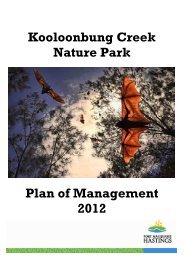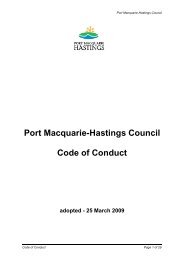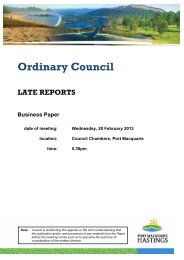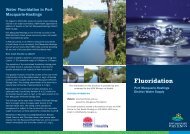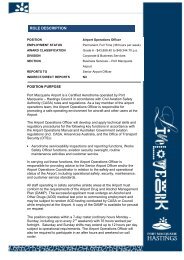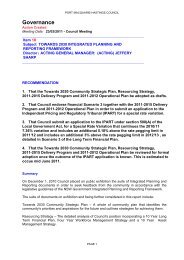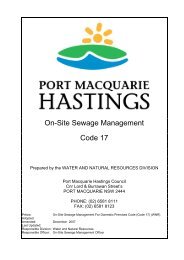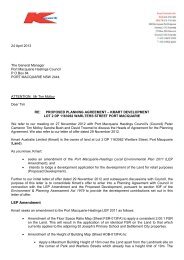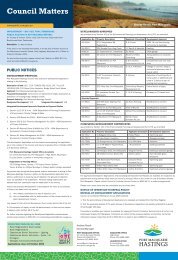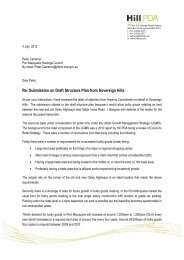Patterson Britton & Partners Pty Ltd - Hastings Council - NSW ...
Patterson Britton & Partners Pty Ltd - Hastings Council - NSW ...
Patterson Britton & Partners Pty Ltd - Hastings Council - NSW ...
Create successful ePaper yourself
Turn your PDF publications into a flip-book with our unique Google optimized e-Paper software.
Sydney Office<br />
level 4<br />
104 Mount Street<br />
North Sydney 2060<br />
Newcastle Office<br />
14 Telford Street<br />
Newcastle East 2300<br />
PO Box 515<br />
North Sydney 2059<br />
Australia<br />
PO Box 668<br />
Newcastle 2300<br />
Australia<br />
telephone (02) 9957 1619<br />
facsimile (02) 9957 1291<br />
email: reception@patbrit.com.au<br />
A.C.N. 003 220 228<br />
A.B.N. 89 003 220 228<br />
telephone (02) 4928 7777<br />
facsimile (02) 4926 2111<br />
email: mail@newcastle.patbrit.com.au<br />
<strong>Patterson</strong> <strong>Britton</strong><br />
& <strong>Partners</strong> <strong>Pty</strong> <strong>Ltd</strong><br />
.<br />
<br />
Mr Michael Mowle<br />
lr6715djt_crt070306-LLG Encroachment Asessment.doc<br />
Hopkins Consultants<br />
PO Box 1556<br />
PORT MACQUARIE <strong>NSW</strong> 2444 9 th March 2007<br />
Dear Michael,<br />
AREA 13: THRUMSTER – LEWIS LAND GROUP HOLDINGS, PORT MACQUARIE<br />
FLOODPLAIN ENCROACHMENT ASSESSMENT<br />
I refer to Lewis Land Group’s (LLG) 350 hectare parcel of land which forms part of the Area 13<br />
Urban Expansion Area at Thrumster near Port Macquarie. I also refer to the ‘Thrumster<br />
Integrated Water Management Plan – Flood Study’ (in draft, February 2007), which was prepared<br />
by Maunsell Australia and defines the extent of flood liable land across Area 13 during a range of<br />
design floods.<br />
The results presented in the Flood Study indicate that some sections of land where development<br />
is proposed as part of the Area 13 Urban Expansion are predicted to be inundated during the<br />
design 100 year recurrence flood. This includes sections of land owned by LLG.<br />
The potential flood liability of these sections of land does not necessarily preclude them from<br />
being developed in the future. The <strong>NSW</strong> Government’s ‘Floodplain Development Manual’ (2005)<br />
indicates that development in areas of the floodplain delineated as flood fringe …’would not have<br />
any significant effect on the pattern of flood flows and/or levels.’ Therefore, it is possible that<br />
development could be undertaken across some flood liable sections of the floodplain without<br />
adversely impacting on existing flood behaviour.<br />
Accordingly, Hopkins Consultants, acting on behalf of LLG, engaged <strong>Patterson</strong> <strong>Britton</strong> & <strong>Partners</strong><br />
to use the results from the Maunsell Report and supplementary investigations, to determine<br />
which sections of the LLG land have the potential to be developed or filled in the future. This<br />
involved using the HEC-RAS model that was developed for the Maunsell Report to undertake a<br />
floodplain encroachment assessment for those parcels of land that adjoin Partridge and<br />
Karikaree Creeks. The assessment was targeted toward identifying those sections of the<br />
floodplain where development should be excluded to allow for the conveyance of flood flows.<br />
The results of the floodplain encroachment assessment are presented in the following report.<br />
<br />
<br />
Principals<br />
Senior Associates<br />
Associates<br />
The ‘Floodplain Development Manual’ (2005) characterises flood prone land according to<br />
three hydraulic categories, namely floodway, flood storage and flood fringe. Definitions for<br />
each hydraulic category, which have been taken directly from the Manual are provided in<br />
Table 1.<br />
Greg <strong>Britton</strong> BE MEngSc FIEAust Andrew Chitty BE MIEAust CPEng Peter Coltman BE MEngSc MIEAust<br />
Bruce Druery BE Dip Sc(Geol) M AppSc MIEAust Paul Harvey-Walker BE FIEAust David McConnell BSc MIEAust<br />
Joe Marson BE MEngSc FIEAust Andrew <strong>Patterson</strong> BE FIEAust Christopher Thomas BE MEngSc MIEAust<br />
Mark Tooker BSc(Eng) MEngSc FIEAust CPEng Michael Wright BE MEngSc MIEAust<br />
Steve Barrett Simon Batt BE MIEAust Paul Macinante BE MEnvEngSc MIEAust Ben <strong>Patterson</strong> BE MIEAust<br />
Marc Roberts BE Michael Shaw BE MIEAust CPEng<br />
Stephen Aebi BE MIEAust Neville Boyes OMIEAust Scot Cranfield Cameron Druery BE MIEAust<br />
Adam Knight BE MIEAust CPEng Cameron Smith BE MEngSc MIEAust CPEng<br />
Alexandra Stone BE MIEAust Chris Yates BE MIEAust
<strong>Patterson</strong> <strong>Britton</strong><br />
& <strong>Partners</strong> <strong>Pty</strong> <strong>Ltd</strong><br />
.<br />
Table 1<br />
DEFINITIONS FOR HYDRAULIC CATEGORIES<br />
<br />
<br />
<br />
<br />
<br />
<br />
<br />
<br />
<br />
<br />
<br />
<br />
<br />
<br />
<br />
" #<br />
! <br />
<br />
Based on the definitions provided in Table 1, it can be concluded that filling in floodway<br />
areas will typically generate unacceptable impacts on flood behaviour. These impacts<br />
include significant increases in upstream flood level, increases in peak flow velocity and<br />
major changes in flood behaviour. Therefore, development in floodway areas should not be<br />
undertaken.<br />
Filling in flood storage areas can also have adverse hydraulic impacts on flood behaviour.<br />
Hence, filling in flood storage areas is typically discouraged. However, some filling can occur<br />
provided it does not cause a significant increase in peak flood levels.<br />
Table 1 also indicates that development in flood fringe areas does not typically generate any<br />
significant impacts on existing flood behaviour.<br />
Therefore, the minimum extent to which development can encroach into a floodplain can be<br />
assumed to correspond to the extent of the flood fringe zone. Development can extend<br />
beyond this zone, but it is necessary to show that the impact of the additional extent of<br />
development does not cause an unacceptable impact on flood characteristics; that is, peak<br />
level and peak flow velocity.<br />
Accordingly, the extent to which urban development can occur across the LLG land at<br />
Thrumster can be established by defining the corridor of land adjacent to Partridge and<br />
Karikaree Creeks, which if filled would cause an unacceptable increase in peak flood level.<br />
This extent of developable floodplain will typically lie somewhere between the extent of the<br />
flood fringe zone and the upslope boundary of the floodway zone.<br />
!" # # # # $ %<br />
As discussed, development can generally be undertaken in flood fringe areas without<br />
significantly impacting on existing flood behaviour. Development can also be undertaken in<br />
flood storage areas, provided the impact of that development is not significant or<br />
compensatory works are undertaken. The Manual defines a significant impact as an<br />
increase in peak flood level of greater than 0.1 metres (refer Table 1).<br />
2
<strong>Patterson</strong> <strong>Britton</strong><br />
& <strong>Partners</strong> <strong>Pty</strong> <strong>Ltd</strong><br />
Therefore, it is possible to determine the extent of the floodplain that could potentially be<br />
developed by defining the extent to which encroachment into the floodplain will not result in<br />
an increase in peak flood level of more than 0.1 metres.<br />
The HEC-RAS hydraulic models that were developed by Maunsell Australia to define the<br />
extent of flood liable land across Area 13 were obtained and used to undertake a floodplain<br />
encroachment assessment. The purpose of the floodplain encroachment analysis is to<br />
determine the limit of development/filling that will cause a maximum change in water surface<br />
elevation of no more than 100 mm. This procedure can be undertaken with the HEC-RAS<br />
software by using an iterative (i.e., trial-and-error) approach.<br />
The floodplain encroachment was undertaken for the design 100 year recurrence flood for<br />
the three major creeks draining through the LLG land, namely:<br />
• Partridge Creek (referred to as Catchment A in the Maunsell Flood Study Report);<br />
• Unnamed Creek (referred to as Catchment C in the Maunsell Flood Study Report); and,<br />
• Karikaree Creek (referred to as Catchment D in the Maunsell Flood Study Report).<br />
Only those HEC-RAS model cross-sections falling within the LLG land were considered as<br />
part of the floodplain encroachment analysis.<br />
An example of the output from the encroachment assessment is presented in Plate 1. This<br />
shows the position of “floodplain encroachment stations” which define the maximum extent of<br />
filling or development that is possible along Karikaree Creek at HEC-RAS model crosssection<br />
814. The position of the floodplain encroachment stations was determined by<br />
simulating trial encroachment extents until the encroachment caused increases in peak flood<br />
level of less than 100 mm.<br />
.<br />
Catch Drevch210207 Plan: Plan 01 3/5/2007<br />
11<br />
10<br />
.06 .05 .06<br />
Legend<br />
WS 100 Yr Encroachm<br />
WS 100 Yr Existing<br />
Ground<br />
Levee<br />
Bank Sta<br />
Encroachment<br />
9<br />
Elevation (m)<br />
8<br />
7<br />
6<br />
5<br />
0 100 200 300 400 500<br />
<br />
Station (m)<br />
& ' ( ) ) ) <br />
<br />
3
<strong>Patterson</strong> <strong>Britton</strong><br />
& <strong>Partners</strong> <strong>Pty</strong> <strong>Ltd</strong><br />
The floodplain encroachment stations that were determined for each model cross-section<br />
were extracted from the HEC-RAS model results and transferred to a spatial (i.e., GIS)<br />
framework and used to develop a plan of acceptable encroachment extent. The<br />
encroachment extent between model cross-sections was determined by interpolating<br />
between the encroachment extent for successive cross-sections relative to the ALS<br />
topographic data. Peak flood level estimates at each model cross-section were also<br />
combined with the ALS data to determine the extent of flood liable land at the peak of the<br />
design 100 year recurrence flood.<br />
The encroachment (i.e., development/filling) extent for Catchment A is shown in Figure 1 as<br />
the light blue shaded area. The encroachment extents for Catchments C and D are<br />
presented in Figure 2. The red areas provided in Figures 1 and 2 show the extent of the<br />
floodplain that needs to be retained for the conveyance of flood flows. It is likely that a large<br />
proportion of the red areas would be considered to fall within floodway zones. Development<br />
or filling of these areas is likely to generate unacceptable increases in peak flood levels, and<br />
therefore, should be avoided.<br />
In general, Figures 1 and 2 show that the majority of those areas where urban development<br />
is proposed are located outside of the red areas. Notwithstanding, there are some places<br />
along Partridge Creek, the unnamed creek and the northern arm of Karikaree Creek, where<br />
development is proposed to extend into the red areas. Consideration should be given to<br />
excluding development from these areas or providing suitable measures to mitigate any<br />
adverse flood impacts should development of these areas proceed in the future .<br />
<br />
Investigations undertaken for this report have determined the maximum potential extent of<br />
filling that could be undertaken across flood liable sections of the LLG site at Area 13 without<br />
adversely impacting on existing flood behaviour. The maximum extent of filling or<br />
encroachment along the primary tributaries of Catchment A (i.e., Partridge Creek) is<br />
represented by the light blue areas shown in Figure 1. The maximum extent of<br />
encroachment along Karikaree Creek is represented by the light blue areas shown in<br />
Figure 2.<br />
Figures 1 and 2 show the flood liable sections of the LLG land that could potentially be filled<br />
without significantly impacting on existing flood behaviour. They also show those areas of<br />
the floodplain where development should be excluded to allow for the conveyance of flood<br />
flows. These areas are shown in red on each of the figures.<br />
It should be recognised that the encroachment extents presented in Figures 1 and 2 should<br />
be used as a guide to the maximum potential extent of development that could be<br />
undertaken. Furthermore, the boundaries of the red coloured areas on both figures should<br />
be “smoothed” to more realistically represent “floodway” zones.<br />
It should also be recognised that the encroachment assessment documented in this report<br />
has been completed using a broad-scale, one-dimensional, steady state hydraulic model. It<br />
is considered that more detailed two-dimensional hydrodynamic modelling will be required to<br />
assess individual development proposals during the subsequent Development Application<br />
phase of the project.<br />
.<br />
4
<strong>Patterson</strong> <strong>Britton</strong><br />
& <strong>Partners</strong> <strong>Pty</strong> <strong>Ltd</strong><br />
.<br />
* <br />
Port Macquarie - <strong>Hastings</strong> <strong>Council</strong> (April 2006), ‘Area 13 Investigations Area: Structure<br />
Plan – Urban Design Guidelines’; prepared by Deicke Richards.<br />
Port Macquarie - <strong>Hastings</strong> <strong>Council</strong> (6 th October 2006), ‘Area 13: Thrumster’;<br />
http://www.hastings.nsw.gov.au/www/html/2393-area-13-thrumster.asp, accessed 11 th<br />
October, 2006.<br />
Port Macquarie - <strong>Hastings</strong> <strong>Council</strong> (August 2006), ‘<strong>Hastings</strong> River Flood Study’; prepared<br />
by <strong>Patterson</strong> <strong>Britton</strong> & <strong>Partners</strong>.<br />
Port Macquarie - <strong>Hastings</strong> <strong>Council</strong> (February 2007), ‘Thrumster Integrated Water<br />
Management Plan – Flood Study’; prepared by Maunsell Australia.<br />
New South Wales Government (2005), ‘Floodplain Development Manual: the<br />
management of flood liable land’; ISBN 0 7347 5476 0.<br />
---------------------------------<br />
We trust that the above report addresses your needs. Please feel free to contact me should you<br />
require any further information.<br />
Yours faithfully<br />
PATTERSON BRITTON<br />
Chris Thomas<br />
Principal<br />
5
Sydney Office<br />
level 4<br />
104 Mount Street<br />
North Sydney 2060<br />
Newcastle Office<br />
14 Telford Street<br />
Newcastle East 2300<br />
PO Box 515<br />
North Sydney 2059<br />
Australia<br />
PO Box 668<br />
Newcastle 2300<br />
Australia<br />
telephone (02) 9957 1619<br />
facsimile (02) 9957 1291<br />
email: reception@patbrit.com.au<br />
A.C.N. 003 220 228<br />
A.B.N. 89 003 220 228<br />
telephone (02) 4928 7777<br />
facsimile (02) 4926 2111<br />
email: mail@newcastle.patbrit.com.au<br />
<strong>Patterson</strong> <strong>Britton</strong><br />
& <strong>Partners</strong> <strong>Pty</strong> <strong>Ltd</strong><br />
.<br />
consulting engineers<br />
Mr Michael Mowle<br />
lt6715djt_crt070413-Additional Hydraulic Investigations.doc<br />
Hopkins Consultants<br />
PO Box 1556<br />
PORT MACQUARIE <strong>NSW</strong> 2444 30 th April 2007<br />
Dear Michael,<br />
AREA 13: THRUMSTER – LEWIS LAND GROUP HOLDINGS, PORT MACQUARIE<br />
OUTCOMES OF ADDITIONAL FLOOD INVESTIGATIONS<br />
I refer to our letter dated 9 th March 2007, which summarised the outcomes of a floodplain<br />
encroachment assessment that we completed for Lewis Land Group’s (LLG) land holdings at<br />
Thrumster near Port Macquarie. The purpose of the floodplain encroachment analysis was to<br />
determine those sections of the floodplains that could potentially be filled for future urban uses<br />
without adversely impacting on existing flood behaviour. It is understood that the results from this<br />
analysis are being used to assist in establishing suitable zoning boundaries for the Area 13<br />
Expansion Precinct.<br />
Since the submission of our letter, we understand that additional work has been completed to<br />
refine the zoning boundaries that are being developed for LLG’s land. As a result of this<br />
additional work, we understand that you require further investigations to be undertaken to<br />
determine:<br />
• the potential to undertake further encroachment along the northern arm of Karikaree Creek<br />
(i.e., Catchment D) and the unnamed creek (i.e., Catchment C); and,<br />
• the potential to “pipe” minor tributary inflows to Partridge Creek.<br />
We also understand that you would like us to assess the potential impact that the adopted<br />
tailwater levels in the HEC-RAS hydraulic model of Partridge Creek may have on peak design<br />
flood levels across LLG’s land. Specifically, this is to involve an assessment of the potential to<br />
adopt a lower tailwater level for the design of stormwater structures, sewerage treatment facilities<br />
etc.<br />
Accordingly, we have considered the additional issues that you have raised and are pleased to<br />
provide the outcomes of our investigations in the following report.<br />
1. IMPACT OF ADOPTED TAILWATER ELEVATION ON PEAK FLOOD LEVELS ALONG PARTRIDGE<br />
CREEK<br />
Existing design flood behaviour along Partridge Creek has been defined based on the results<br />
of flood modelling that has been completed for Port Macquarie – <strong>Hastings</strong> <strong>Council</strong> by<br />
Maunsell Australia <strong>Pty</strong> <strong>Ltd</strong>. The flood model of Partridge Creek was developed using the<br />
steady state, one-dimensional HEC-RAS software.<br />
Principals<br />
Senior Associates<br />
Associates<br />
Greg <strong>Britton</strong> BE MEngSc FIEAust Andrew Chitty BE MIEAust CPEng Peter Coltman BE MEngSc MIEAust<br />
Bruce Druery BE Dip Sc(Geol) M AppSc MIEAust Paul Harvey-Walker BE FIEAust David McConnell BSc MIEAust<br />
Joe Marson BE MEngSc FIEAust Andrew <strong>Patterson</strong> BE FIEAust Christopher Thomas BE MEngSc MIEAust<br />
Mark Tooker BSc(Eng) MEngSc FIEAust CPEng Michael Wright BE MEngSc MIEAust<br />
Steve Barrett Simon Batt BE MIEAust Paul Macinante BE MEnvEngSc MIEAust Ben <strong>Patterson</strong> BE MIEAust<br />
Marc Roberts BE Michael Shaw BE MIEAust CPEng<br />
Stephen Aebi BE MIEAust Neville Boyes OMIEAust Scot Cranfield Cameron Druery BE MIEAust<br />
Adam Knight BE MIEAust CPEng Cameron Smith BE MEngSc MIEAust CPEng<br />
Alexandra Stone BE MIEAust Chris Yates BE MIEAust
<strong>Patterson</strong> <strong>Britton</strong><br />
& <strong>Partners</strong> <strong>Pty</strong> <strong>Ltd</strong><br />
In order to define flood behaviour along Partridge Creek, information on design inflows from<br />
the Partridge Creek catchment is required. The design inflows were estimated using results<br />
generated by a RAFTS hydrologic computer model of the Partridge Creek catchment.<br />
In addition to catchment inflows, a water level must be specified at the downstream end of<br />
the HEC-RAS model in order for a “backwater” profile to be calculated.<br />
In assessing peak flood levels for Area 13, Maunsell has adopted a tailwater level at the<br />
downstream boundary of Partridge Creek that corresponds to the peak 100 year recurrence<br />
flood level for the <strong>Hastings</strong> River. Maunsell has assumed that this peak 100 year recurrence<br />
<strong>Hastings</strong> River flood level occurs in conjunction with a peak 100 year recurrence flood along<br />
Partridge Creek. That is, Maunsell has assumed that peak 100 year recurrence design flood<br />
levels in the <strong>Hastings</strong> River and along Partridge Creek occur simultaneously.<br />
However, the occurrence of a 100 year recurrence <strong>Hastings</strong> River flood occurring<br />
concurrently with the peak of the 100 year recurrence Partridge Creek is likely to have a<br />
recurrence interval of well in excess of 100 years. This is because flooding along the<br />
<strong>Hastings</strong> River generally occurs as a result of extended periods of rainfall (i.e., 72 hours),<br />
whereas flooding along Partridge Creek occurs as a result of comparatively short duration<br />
rainfall bursts (i.e., between 1.5 and 9 hours).<br />
Therefore, it is less likely that both rainfall mechanisms will occur over the <strong>Hastings</strong> and<br />
Partridge Creek catchments simultaneously. As a result, the approach adopted by Maunsell<br />
is considered to be very conservative.<br />
As part of the ‘<strong>Hastings</strong> River Flood Study’ (2006), it was determined that a 100 year<br />
recurrence <strong>Hastings</strong> River flood occurring in conjunction with a peak 20 year recurrence<br />
ocean tailwater level, provided a conservative and reliable estimate of design flood behaviour<br />
along the lower reaches of the <strong>Hastings</strong> River. Accordingly, it is considered that a similar<br />
approach may be suitable to define design flood characteristics for the Partridge Creek<br />
catchment.<br />
In order to determine the sensitivity of the results generated by the HEC-RAS model to<br />
variations in the adopted tailwater elevation, the 100 year recurrence Partridge Creek flood<br />
was re-simulated with a 20 year recurrence <strong>Hastings</strong> River tailwater elevation. Results<br />
documented in the <strong>Hastings</strong> River Flood Study indicate that the 20 year recurrence <strong>Hastings</strong><br />
River flood level along the lower reaches of Partridge Creek is 2.6 mAHD. This is about<br />
800 mm lower than the 100 year recurrence tailwater level of 3.4 mAHD adopted by<br />
Maunsell.<br />
The results of the revised design flood simulations are summarised in Table 1 for selected<br />
HEC-RAS model cross-sections along Partridge Creek. The location of the model crosssection<br />
are shown in Figure 1.<br />
The results listed in Table 1 show that peak 100 year recurrence flood levels along the lower<br />
reaches of Partridge Creek are sensitive to changes in the adopted tailwater level (refer<br />
cross-sections 2008 to 3315). Across the LLG land, peak 100 year recurrence flood levels<br />
are predicted to reduce by up to 300 mm (refer cross-section 2198.4). However, the<br />
decreases in peak 100 year flood levels across the majority of the LLG land are generally<br />
less than 200 mm.<br />
.<br />
2
<strong>Patterson</strong> <strong>Britton</strong><br />
& <strong>Partners</strong> <strong>Pty</strong> <strong>Ltd</strong><br />
.<br />
Table 1<br />
IMPACT OF ADOPTED TAILWATER ELEVATIONS ON PEAK 100 YEAR<br />
RECURRENCE FLOOD LEVELS ALONG PARTRIDGE CREEK<br />
HEC-RAS MODEL<br />
CROSS-SECTION<br />
(refer Figure 1)<br />
100 Year Tailwater<br />
(mAHD)<br />
PEAK DESIGN FLOOD LEVELS<br />
20 Year Tailwater<br />
(mAHD)<br />
Difference<br />
(metres)<br />
2008 3.54 3.17 -0.37<br />
2198.4 3.60 3.31 -0.29<br />
2293.6 3.65 3.42 -0.23<br />
2388.8 3.72 3.55 -0.17<br />
2484 3.82 3.7 -0.12<br />
2571.5 3.86 3.76 -0.1<br />
2659 3.89 3.8 -0.09<br />
2669 3.89 3.8 -0.09<br />
3012 4.07 4.01 -0.06<br />
3305 4.36 4.34 -0.02<br />
3315 4.34 4.31 -0.03<br />
3628 5.21 5.21 0<br />
3784 5.61 5.61 0<br />
3867 5.92 5.92 0<br />
3950 7.01 7.01 0<br />
4033 8.31 8.31 0<br />
4121.6 9.26 9.26 0<br />
4298.8 10.98 10.98 0<br />
Reductions in peak flood levels of this magnitude are predicted to reduce the lateral extent of<br />
inundation along the lower reaches of Partridge Creek by up to 4 metres. Peak flood levels<br />
and, therefore, the lateral extent of inundation along the steeper upper reaches of Partridge<br />
Creek are not predicted to change.<br />
Therefore, the adoption of a 20 year recurrence tailwater level is predicted to have only<br />
relatively minor impacts on peak flood levels and the extent of inundation along that section<br />
of Partridge Creek draining through LLG land.<br />
Nevertheless, we consider that the adoption of a 20 year recurrence <strong>Hastings</strong> River tailwater<br />
level provides a suitable basis for the design of services and infrastructure within the Area 13<br />
precinct. However, we would advocate a more conservative approach when establishing<br />
minimum floor level requirements for buildings.<br />
Accordingly, we suggest that the 100 year recurrence <strong>Hastings</strong> River tailwater level should<br />
be adopted when establishing minimum floor levels for future residential and commercial<br />
buildings across Area 13. A 20 year recurrence tailwater level could safely be adopted for<br />
the design of stormwater structures, sewerage treatment facilities etc.<br />
3
<strong>Patterson</strong> <strong>Britton</strong><br />
& <strong>Partners</strong> <strong>Pty</strong> <strong>Ltd</strong><br />
.<br />
2. POTENTIAL TO “PIPE” TRIBUTARY INFLOWS TO PARTRIDGE CREEK<br />
As shown in Figure 1, a major tributary of Partridge Creek extends in a northerly direction<br />
from the Oxley Highway through a section of the Area 13 expansion precinct that is<br />
designated for potential future urban development. Therefore, additional investigations were<br />
completed to assess the potential to “pipe” flows (i.e., carry surface runoff along a subsurface<br />
pipe system) along this tributary in order to maximise the potential developable<br />
“footprint”.<br />
Available survey information for the tributary indicates that the creek channel is poorly<br />
defined. As shown in Plate 1, the tributary comprises a relatively flat depression that is<br />
approximately 40 metres in width. Plate 1 also shows that the tributary comprises negligible<br />
riparian vegetation.<br />
PLATE 1<br />
VIEW LOOKING NORTH FROM THE OXLEY HIGHWAY SHOWING THE LIMITED EXTENT OF<br />
RIPARAIN VEGETATION ALONG THE SOUTH-EASTERN TRIBUTARY OF PARTRIDGE CREEK<br />
Flooding along this tributary was previously considered as part of the floodplain<br />
encroachment assessment that was previously completed for Partridge Creek (refer<br />
Figure 1). The results of the assessment indicated that a 10 to 14 metre wide corridor would<br />
need to be maintained along the tributary to convey flood flows without significantly<br />
impacting on existing flood behaviour. That is, fill could potentially be placed to within 5 to<br />
7 metres of the centreline of the tributary.<br />
Nevertheless, there is potential to further decrease the required creek corridor width by<br />
conveying a proportion of the total design flow via a sub-surface pipe network. In this way, a<br />
reduced proportion of the design flow could be conveyed overland, thereby allowing a<br />
greater degree of encroachment/filling.<br />
4
<strong>Patterson</strong> <strong>Britton</strong><br />
& <strong>Partners</strong> <strong>Pty</strong> <strong>Ltd</strong><br />
It is considered that runoff from the catchment would be managed in accordance with the<br />
principles of the major / minor concept outlined in ‘Australian Rainfall & Runoff – A Guide to<br />
Flood Estimation’ (1987). The minor system would comprise the gutter and pipe network<br />
which will be designed to carry runoff generated during the smaller more frequent storms;<br />
e.g., up to and including the 10 or 20 year recurrence event. The major system would<br />
comprise both formal and informal drainage pathways (e.g., grass swales) that convey the<br />
residual of the runoff to Partridge Creek (i.e., flows in excess of the capacity of the pipe<br />
system up to and including the 100 year recurrence event).<br />
It is considered appropriate to provide a formalised overland flowpath for the major system in<br />
close proximity to the alignment of the existing tributary as there will be a natural tendency<br />
for surface runoff to be carried to this location. Therefore, even if a piped system was<br />
implemented, it would still be necessary to provide a “development free” corridor in close<br />
proximity to the existing tributary in order to safely convey runoff in excess of the capacity of<br />
the pipe system.<br />
Notwithstanding, it is considered that the overland flowpath could be engineered to provide<br />
increased conveyance capacity, thereby increasing the potential to fill within close proximity<br />
of the creek.<br />
In order to provide an indication of the potential increased encroachment that could be<br />
achieved if a proportion of the runoff is conveyed via a pipe system, a revised encroachment<br />
analysis was completed. The revised encroachment assessment was completed by<br />
assuming 50% of the design 100 year recurrence flow was conveyed via a sub-surface pipe<br />
system. The residual flow was assumed to be conveyed along the existing tributary.<br />
The results of the revised encroachment analysis are superimposed on Figure 2. This figure<br />
shows that the required corridor width would reduce from between 10 and 14 metres to<br />
between 6 and 11 metres.<br />
Accordingly, although the provision of a piped system will reduce the required floodway/flood<br />
storage corridor width, it will not remove the need for the corridor completely. Therefore,<br />
even if a piped drainage system was implemented as part of any future development of the<br />
area, a corridor with a typical width of about 10 metres will still be required to convey flows<br />
during large storms.<br />
3. ENCROACHMENT ASSESSMENT FOR KARIKAREE CREEK AND UNNAMED CREEK<br />
As discussed, an encroachment analysis was completed for the three catchments draining<br />
through LLG’s land. The purpose of the encroachment analysis was to determine the extent<br />
of the floodplain areas that could potentially be filled to accommodate future urban<br />
development. This information, in conjunction with a range of other information (e.g., riparian<br />
corridor boundaries) has been used to refine the zoning boundaries that have been<br />
developed for LLG’s land holdings in the Area 13 Expansion Precinct.<br />
The revised zoning boundaries that have been developed for urban sections of LLG’s land<br />
are generally located outside of the “floodway” and “flood storage” areas that were defined<br />
as part of the encroachment analysis. This indicates that future urban development in these<br />
areas will not result in unacceptable impacts on existing flood behaviour; i.e., increases in<br />
peak flood level of more than 100 mm.<br />
However, one of the proposed urban areas along the northern floodplain of Karikaree Creek<br />
is predicted to locally extend into an area of the floodplain that was previously delineated as<br />
a potential floodway/flood storage area.<br />
.<br />
5
<strong>Patterson</strong> <strong>Britton</strong><br />
& <strong>Partners</strong> <strong>Pty</strong> <strong>Ltd</strong><br />
In addition, some urban areas as well as the proposed realignment of the Oxley Highway are<br />
predicted to extend into an area of the floodplain of the Unnamed Creek (i.e., Catchment C)<br />
that was previously delineated as a floodway/flood storage area<br />
Accordingly, additional investigations were completed to assess whether additional<br />
encroachment across these areas may generate unacceptable impacts on existing flood<br />
behaviour.<br />
The assessment was completed by incorporating the additional encroachment along the<br />
northern floodplain of Karikaree Creek and along the Unnamed Creek, into the existing<br />
HEC-RAS model. The 100 year recurrence flood was then re-simulated and peak flood<br />
levels determined from the revised simulation were compared against peak 100 year<br />
recurrence flood levels for existing conditions.<br />
The results of the revised encroachment simulations show that the additional encroachment<br />
would generate localised increases in peak 100 year recurrence flood levels. However, the<br />
maximum increase in peak 100 year recurrence flood level along Karikaree Creek is<br />
predicted to be less than 100 mm. In addition, the additional encroachment is not predicted<br />
to increase peak flood levels along the Unnamed Creek by more than 100 mm.<br />
The results of the revised encroachment assessment are presented in Figure 2. The results<br />
of the original encroachment assessment have been superimposed for comparison.<br />
Overall, it is considered that the additional encroachment along both Karikaree Creek and<br />
the Unnamed Creek, can be accommodated without unacceptably impacting on existing<br />
flood behaviour along each watercourse.<br />
4. REFERENCES<br />
• Port Macquarie - <strong>Hastings</strong> <strong>Council</strong> (August 2006), ‘<strong>Hastings</strong> River Flood Study’; prepared<br />
by <strong>Patterson</strong> <strong>Britton</strong> & <strong>Partners</strong>.<br />
• Port Macquarie - <strong>Hastings</strong> <strong>Council</strong> (February 2007), ‘Thrumster Integrated Water<br />
Management Plan – Flood Study’; prepared by Maunsell Australia.<br />
• New South Wales Government (2005), ‘Floodplain Development Manual: the<br />
management of flood liable land’; ISBN 0 7347 5476 0.<br />
---------------------------------<br />
We trust that the above report addresses your needs. Please feel free to contact me should you<br />
require any further information.<br />
.<br />
Yours faithfully<br />
PATTERSON BRITTON<br />
Chris Thomas<br />
Principal<br />
6



